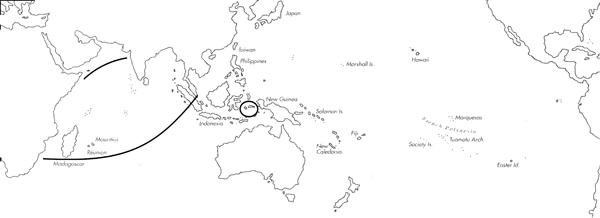
Skip Navigation Links
View access keys for this site.

Range: E. Africa to W. Thailand; probably Moluccas.
Description: Medium-sized to moderately large, solid to heavy. Last whorl conical; outline convex at adapical third, slightly concave at central third and almost straight below. Shoulder subangulate to sharply angulate. Spire usually low; outline concave to convex. Larval shell of about 2 wide whorls. Teleoconch sutural ramps concave, with densely set, fine to pronounced axial threads crossing 3-4 major spiral grooves in later whorls; additional spiral threads on last ramps. Last whorl with closely spaced spiral threads from base to shoulder.
| Shell Morphometry | ||
|---|---|---|
| L | 50-76 mm | |
| RW | 0.53-1.27 g/mm | |
| (L 50-68 mm) | ||
| RD | 0.57-0.69 | |
| PMD | 0.85-0.93 | |
| RSH | 0.05-0.13 | |
Ground colour cream, suffused with yellow or orange. Last whorl with numerous spiral rows of fine reddish brown dots from base to shoulder and with a spiral band of reddish brown to dark brown axial blotches on each side of centre. Larval shell white. Teleoconch sutural ramps with moderately dense, reddish to dark brown, curved axial streaks, often reduced to a pre-sutural and a sub-sutural row of spots. Aperture white, often variously tinged with orange. Periostracum greyish brown to blackish brown, thick, opaque, and axially ridged.
Habitat and Habits: In 3-25 m; living in muddy sand, on coral rubble and beneath rocks.
Discussion: C. augur is a very distinctive species characterized by a striking conchological uniformity within and between populations.

C. augur Range Map
This section contains verbatim reproductions of the accounts of 316 species of Conus from the Indo-Pacific region, from Manual of the Living Conidae, by Röckel, Korn and Kohn (1995). They are reproduced with the kind permission of the present publisher, Conchbooks.
All plates and figures referred to in the text are also in Röckel, Korn & Kohn, 1995. Manual of the Living Conidae Vol. 1: Indo-Pacific Region.
The range maps have been modified so that each species account has it own map, rather than one map that showed the ranges of several species in the original work. This was necessary because each species account is on a separate page on the website and not confined to the order of accounts in the book.
Return to framed version (returns to search page)